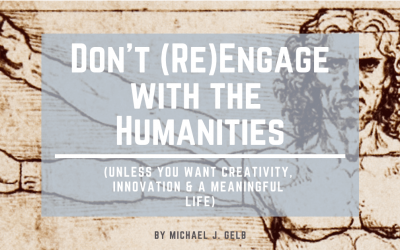
Written by Michael J. Gelb
Utilizing Creativity to Manage Change
I led my first 5-day management retreat for the International Field Service Leadership Team of Digital Equipment Corporation (DEC) in 1979. The theme was “Utilizing creativity to deal with accelerating change.” DEC’s Field Service Team was ahead of the curve relative to the rest of the company. But their corporate leadership failed to anticipate the rise of the personal computer, and eventually Compaq acquired DEC.
Years later I gave a keynote speech at the global management conference for Compaq and reconnected with many of the participants from our original seminar. Then, a few years after that, I worked with Hewlett-Packard when it acquired Compaq. None of us knew, in that first seminar, just how fast change would accelerate.
The One Key Trait for Successful Entrepreneurs
As the rate of change accelerated through the 1980s and 90s, corporations began to seek managers with a high “tolerance for ambiguity.” More recently, Forbes described tolerance for ambiguity as “The One Key Trait for Successful Entrepreneurs.”
Psychologists define three causes for the anxiety associated with ambiguity: novelty, complexity, and perceived insolubility. In other words, if its new, complicated, and you don’t have any idea how to solve it, you experience anxiety. Creativity, in art or business, requires finding something new, simplifying the complex, and discovering solutions that are unexpected.
Embrace Ambiguity
So, let’s replace the notion of tolerating ambiguity with the idea of embracing it.
The ability to embrace ambiguity and change is the most distinguishing characteristic of the creative mind. This isn’t just for artists, it’s now an essential competency for everyone.
Leonardo da Vinci understood this five hundred years ago. His Mona Lisa is the most famous work of art in history, renowned for her mysterious smile.

Why is Mona Lisa smiling?
The best way to discover this is to assume Mona’s posture and imitate her famous smile. Try this for ten seconds now.
How do you feel when you smile like Mona Lisa? I recently asked this question to a group of gifted children. After a few moments, a girl sitting in the back of the room exclaimed, “She’s got a secret.” And then a boy in the front said, “She knows that everything has an opposite!” And then the children offered examples — light and dark, good and bad, night and day, life and death.
When I led the same exercise with a corporate group, one person responded, “I read in the Wall Street Journal that the famous smile was caused by a dental problem.”
The gifted boys and girls did a much better job of perceiving Mona’s expression of perspective in the face of uncertainty. Mona’s fame, in addition to the unprecedented mastery in her execution, rests on the ambiguity that da Vinci creates, the sense of dynamic tension. The ability to embrace dynamic tension is at the heart of the creative process and it’s even more important now than it was in the Renaissance.
Legendary CEO Jack Welch advised, “Change before you have to.” So learn to smile in the face of change now, and know that uncertainty sets the stage for real creativity.
For more help with managing change, visit MichaelGelb.com
Related Articles
Don’t (re)engage with the humanities
About ten years ago the magazine of the U.S. Bureau of Labor Statistics published an article entitled “What Can I Do With My Liberal Arts Degree?” The article begins by asking a question that many parents have asked their children when they announced that they wanted...


